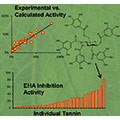Advances in Polyphenol Research: A Journal of Agricultural and Food Chemistry Virtual Issue
Scientists have investigated polyphenols since at least the start of the 19th century, and these compounds continue to be the subject of intense activity, with some 500 papers published in just the Journal of Agricultural and Food Chemistry (JAFC) between January 2016 and July 2017. JAFC has organized a Virtual Issue to highlight recent notable advances in our understanding of polyphenol chemistry, metabolism, and health benefits. 22 of the >500 papers were selected in terms of their excellence and novelty in their hypothesis and methodology. NCRG had 4 papers in JAFC during this time and 50% of these made into the top 4%.

Drought Effects on Proanthocyanidins in Sainfoin (Onobrychis viciifolia Scop.) Are Dependent on the Plant’s Ontogenetic Stage
Carsten S. Malisch, Juha-Pekka Salminen*, Roland Kölliker, Marica T. Engström, Daniel Suter, Bruno Studer, and Andreas Lüscher
J. Agric. Food Chem., 2016, 64 (49), pp 9307–9316
DOI: 10.1021/acs.jafc.6b02342

Chemical Structures of Plant Hydrolyzable Tannins Reveal Their in Vitro Activity against Egg Hatching and Motility of Haemonchus contortus Nematodes
M. T. Engström*, M. Karonen, J. R. Ahern, N. Baert, B. Payré, H. Hoste, and J.-P. Salminen
J. Agric. Food Chem., 2016, 64 (4), pp 840–851
DOI: 10.1021/acs.jafc.5b05691
Early studies on polyphenols focused on structure determination, and while structural characterization of the more complex polyphenols continues, since the end of the 20th century, there has been an increasing emphasis on biological activity, both in planta and after consumption by humans and domesticated animals. Collectively, these papers highlight the importance of agronomical and climatological conditions on the polyphenol concentration, identify new plant sources of polyphenols and new genetic targets to increase or select for specific polyphenols present in plant material, elucidate the mechanisms and products of polyphenol transformations during food processing, and study the possible mechanisms by which polyphenols can provide nutritional protection against abiotic and biotic toxicity or chronic diseases in humans and animals. The gut microbiota interaction with polyphenols and the potential of nanotechnology for enhanced delivery of polyphenols are also illustrated.
See the whole Editorial text of the Virtual Issue at http://pubs.acs.org/doi/full/10.1021/acs.jafc.7b04055
The Virtual Issue can be found at http://pubs.acs.org/page/jafcau/vi/polyphenols-research.html
